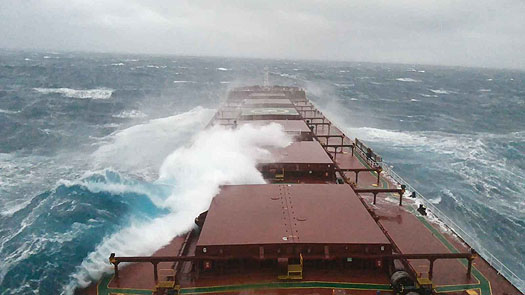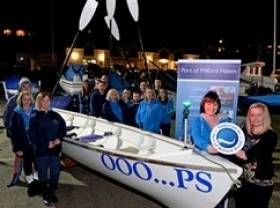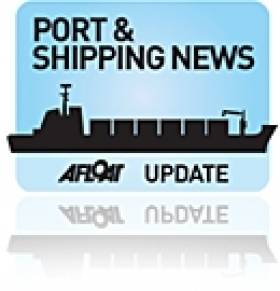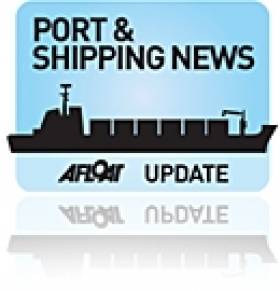Displaying items by tag: Ports and Shipping
Port Shines a Light on Pembrokeshire Yacht Club
#PortYachtClub - Pembrokeshire Yacht Club members have strengthened their commitment to safety on the Waterway after securing sponsorship from the Port of Milford Haven.
The club applied to the Port’s Community Fund in order to purchase new navigation lights for their five longboats which are used by the rowing section in Gelliswick.
Emma Gent from Pembrokeshire Yacht Club, said “We are delighted with our new navigation lights, they have allowed us to continue with our training throughout the winter safely in the Haven. We would like to thank the Port of Milford Haven for their continued support.”
Assistant Harbourmaster and Chair of the Community Fund John Warneford, commented “We were pleased to be able to help PYC in securing new navigation lights as it will ensure their boats are well lit and detectable to others on the Waterway. Safety is our number one priority and anything that clubs and individuals can do to enhance their own safety measures is very much welcomed.”
To apply to the Community Fund, please visit: www.mhpa.co.uk/financial-support
IMDO Review: Waterford Dredging, Container Reliability Slips & VLCC Newbuilds Decline
#IMDOreview -The Irish Maritime Development Office (IMDO) latest Weekly Market Review has among the following stories as outlined below.
Irish Maritime News: Waterford Estuary Dredging to Take Place as reported by Afloat.ie. The trailing suction hopper dredger, Freeway is working on removing silt from the shipping channel between Belview Port and out to the open sea.
Also reported on the IMDO Review and on our coverage is the Department of Transport which has outlined new SOLAS requirements for verification of the gross mass of shipping containers.
Global Container Market: Container Service Reliability Starts 2016 on a Disappointing Note. According to Carrier Performance Insight, the online schedule reliability tool provided by Drewry Supply Chain Advisors container service reliability started 2016 on a disappointing note as the average ontime performance slipped by 5.7 percentage points in January to 69.6%.
Tanker Market: VLGG Rates to Come Under. Further Pressure with the Delivery of 48 Vessels in 2016. Very Large Gas Carriers have fallen 68% from last year’s peaks and are currently near two year lows. The delivery of 48 vessels in 2016, in addition to the 35 delivered in 2015, is likely to dampen spot rates further according to shipping brokers this week.
Bulk Market: Freight Rates for Capesize Bulk. Carriers Likely to Remain Flat on Key Asian Routes. On key Asian routes, freight rates for capesize bulk carriers are likely to remain flat. This is because vessel supply is currently outpacing demand while at the same time higher bunker prices could support freight rates.
For more on the above stories and other news items, click the IMDO Market Review (Week 7) here.
In addition to further dedicated coverage visit Afloat.ie's Ports & Shipping news.
'Unprecedented Opportunity' for Shannon Foynes Port As Trade Hub
#FoynesPort - An “unprecedented opportunity" for Foynes Port and the Shannon Estuary to become a centre of international trade with the potential for up to 3,000 jobs in the coming years, reports The Limerick Leader.
That is according to MEP Sean Kelly who is urging the European Union to recognise the port’s strategic importance.
The Fine Gael MEP recently attended a meeting in Brussels with port company chief executive Pat Keating and the European Commission’s Mobility and Transport Directorate.
“Shannon Foynes is one of a limited number of terminals with deep water facilities in Europe - facilities that no other Irish port enjoys. With the Panama Canal set to double its capacity in 2016, there is an unprecedented opportunity for Europe and for Ireland to capitalise as Shannon Foynes can cater for the huge new vessels that will be coming through,” said Mr Kelly.
To read more about the mid-western seaboard port, click here.
Second ASL Newbuild Takes Shape at Inland Yard
#Hullcompleted - Arklow View (yard no. 722) the second newbuild, currently under construction for Arklow Shipping, made notable progress at a Dutch inland yard on Monday, as the fore and aft sections were joined to form the hull, writes Jehan Ashmore.
The aftship was transported outside from building hall at Royal Bodewes yard in Hoogezand outside Groningen, for connection to the fore-ship. This took place alongside the quay of the north-eastern Dutch shipyard. Close to this location within the yard complex is where the newbuild will be launched sideways into a canal, like leadship, Arklow Vale which made a September spectacular splash!
Arklow View is the latest of the series of 10 ‘V’ class cargoships of the 5,100dwat Bodewes Traders design on order for ASL’s Dutch division, Arklow Shipping Nederland B.V. The 2,999grt series have a Bureau Veritas class Notation of Class 1+ Hull Mach +AUT-UMS, IWS, strength bottom, heavy cargo and general cargo.
The newbuilds feature a distinctive bow from Groot Ship Design, so to minimise wave resistance and improve fuel energy efficiency. At 89m (LOA) long the hull has a total hold capacity of 6258m3 / 221,000ft3 and hatch covers use a Coops & Nieborg pontoon system.
A main powerplant is from a MaK 6M25 1740 kW engine with Siemens Gearbox. This generates a speed of around 14.5 knots and the newbuilds have a Berg controllable pitch propeller.
When work is completed on Arklow View, she will follow the leadship’s wake along the canals connecting to Delfzijl on the Ems Estuary. It was from Delfzijl, where Arklow Vale took sea-trials out into the Wadden Sea before making her maiden repositioning voyage into the North Sea to Ghent.
Arklow Vale was understood to have made her first commercial voyage flying the Dutch flag as she set sail from the Belgium port with an arrival at the weekend to Pasaia in northern Spain.
Tankers Delivered from Asia Completes Ardmore's Newbuilding Programme
#DoubleDelivery - Ardmore Shipping Corporation has been delivered two tanker vessels from yards in Asia, to complete two separate newbuilding programmes as previously reported on Afloat.ie back in August.
Ardmore Chippewa is a 49,999 DWT IMO 2/3 product and chemical tanker delivered by Fukuoka Shipbuilding Co. Ltd, South Korea on 13 November.
Three days later, Ardmore Seahawk, a 25,233 DWT IMO 2 product and chemical tanker built in Nagasaki was delivered from SPP Shipbuilding Co. Ltd.
The addition to the Ardmore fleet of these two modern, fuel efficient vessels increases the number of Ardmore vessels on the water to 24.
Technical management of the Ardmore Chippewa will be provided by Thome Ship Management Pte Ltd while the technical management of the Ardmore Seahawk will be provided by Univan Ship Management Ltd.
Commenting on the two deliveries, Mark Cameron, Ardmore Shipping’s COO, said: “We are pleased to welcome the Ardmore Chippewa and the Ardmore Seahawk to the Ardmore fleet. This brings to the end our four vessel program with Fukuoka Shipbuilding, and also our four vessel program with SPP Shipbuilding. We extend our sincere thanks to both Fukuoka Shipbuilding and SPP Shipbuilding for their diligence, commitment and excellence throughout the build process”.
The COO added, “The addition of these two vessels demonstrates our constant commitment to growing Ardmore’s fleet through state-of-the-art, high quality and efficient vessels to our fleet. With an average age of under four and a half years, the Ardmore fleet is among the youngest in the industry”.
Both newbuilds are high quality eco-design Ardmore vessels, equipped with a variety of fuel-saving measures, including Skysails vessel optimization software, and offering the highest standards of fuel efficiency and operational performance.
Irish Continental Group Acquires Containerships for €24.2 million
#ICGacquireLoLos – The Irish Continental Group (ICG) has entered into agreements for the purchase of four lo-lo container vessels for a total consideration of €24.2 million.
The following three vessels of the quartet are the MV Elbfeeder (built 2008), MV Elbtrader (built 2008) and MV Elbcarrier (built 2007). They each which has a capacity for 980TEU (twenty foot equivalent) and a gross tonnage of 8,246 tons.
This trio of vessels, Afloat understands are currently in operation on the group’s container shipping division EUCON which has more containerships in service on routes between Belfast, Dublin, Cork and Rotterdam and Antwerp.
In addition is the fourth vessel in the acquisition deal, the MV Jork Ranger (built 2005) which has a capacity for 803TEU and a gross tonnage of 7,852 tons.
The MV Elbfeeder will be purchased from MS "Elbfeeder" UG (haftungsbeschrankt) & Co. KG . The MV Elbtrader will be purchased from MS "Elbtrader"GmbH & Co .KG. The MV Elbcarrier will be purchased from MS "Elbcarrier" UG (haftungsbeschrankt) & Co KG. The MV Jork Ranger has been purchased from MS "Jork Ranger" Bernd Becker GmbH & Co KG.
Under the terms of the purchase agreements title to the MV Elbfeeder, MV Elbtrader and MV Elbcarrier will transfer to ICG on delivery of those vessels which is expected in December.
Title to the MV Jork Ranger was transferred to ICG on delivery of that vessel. The purchase consideration is payable in cash on completion. The vessels will be offered to the market on a charter basis.
National Ports Bill Enactment 'Shortly' Says Minister
#ports – Minister for Transport, Tourism & Sport, Paschal Donohoe TD will shortly publish a new Bill to provide for the transfer to local authority control of the five Ports of Regional Significance – Drogheda, Dún Laoghaire, Galway, New Ross and Wicklow. Details of the enactment of this Bill, an important milestone in National Ports Policy, were given during the Minister's Opening Address at the Dublin Bay History and Environment Conference this morning in Dublin.
The Bill will also make a number of improvements to the board appointment process generally such as introducing statutory skillsets and term limits which will improve the overall corporate governance of the sector.
All three of our Ports of National Significance (Tier 1) are hoping that 2015 marks the start of a prolonged period of infrastructure improvements and developments.
'As with the economy at large, we are already seeing and hopefully will continue to see our ports shift from recovery mode to growth mode. This means that we need to ensure that our ports are positioned to provide the type of port capacity we require and I'm confident that National Ports Policy provides the required policy framework to underpin the necessary investments in development' the Minister told the meeting.
The Minister confirmed he supported Dublin Port's most recent application this year for further EU funding towards towards studies required in relation to the Alexandra Basin Redevelopment (ABR) Project.
Mr Donohue said he qwas delighte the port's importance has also been acknowledged as a 'node and core' port within the TEN-T Regulation at European Union level and it is the largest of the three Irish ports on the North Sea Mediterranean Corridor.
The Alexandra Basin Redevelopment (ABR) Project is the core element of Dublin Port Company's Masterplan, endorsed in National Ports Policy, which sets out how the Company will provide the capacity to achieve a throughput of some 60 million tonnes by 2040.
The redevelopment and reconfiguration of Alexandra Basin will allow the Port handle larger ships and to provide for a substantial increase in Port capacity through the provision of multipurpose berths, thus offering a flexible solution for customer needs.
Irish Ports & Shipping Growth Tracks Economic Recovery
#imdo – Ireland's ports and shipping services play an important role as enablers of economic growth. In 2014, port volume increases of more than 2%, as measured by the iShip Index*, tracking Ireland's economic recovery.
Commenting on the 2014 traffic figures, Liam Lacey, Director of the Irish Maritime Development Office said, "Irish ports coped comfortably with the growth recorded in 2014. Total volumes have not yet reached the levels recorded prior to the economic downturn in 2007 and at 914 points, port traffic remains more than 12% behind the high-water mark of 1,042 points recorded in 2007. As a result of the volume gains recorded in recent years and in anticipation of future growth, some of our major ports are now preparing to add capacity and in some cases, development plans are at an advanced stage".
Unitised trade, which includes RoRo and LoLo traffic grew strongly, reflecting both improved export performance and increased consumption in the domestic economy. LoLo traffic grew by 9% to over 793,000 teu, while RoRo traffic was up by 7%, with total volumes exceeding 943,000 vehicles. Total bulk traffic, which includes dry bulk, liquid bulk and break bulk cargoes fell by 2%. This volume decline is largely attributable to the reduced demand for imported fuels and animal feed, resulting from unusually mild weather conditions in 2014.
The growth in traffic was not evenly distributed across the port network. Dublin Port's LoLo and RoRo volumes were up by 9% and 8% respectively and Dublin remains the main port for unitised trade, with 54% of the LoLo market and 49% of the RoRo market. LoLo traffic also grew strongly through the Port of Cork and was up 12% on the previous year, while Rosslare Europort recorded a 1% increase in its RoRo volumes.
Bulk cargoes, which remain concentrated in Shannon Foynes, Cork and Dublin, with 37%, 25% and 20% of the market respectively, increased strongly through Greenore, Drogheda, Galway and Waterford. With the abolition of milk quotas early in 2015, agricultural output is expected to generate spin-off opportunities for regional ports to capitalise on increased agricultural output, as evidenced by the recent decision of Glanbia plc to invest €157mn in a major new dairy facility near Waterford Port.
Ireland's trading performance is affected by international economic influences. Growth in the global economy remained sluggish at 2.6% in 2014 and was lower than initially expected, continuing a pattern of disappointing outturns over the past several years. Within Europe, the competitive realignment brought about by the lower-valued euro, the positive effects of lower oil prices and the strengthening in overall German economic activity have assuaged concerns about recession in Europe. In the context of these macro-economic factors and buoyed by growth in the United Kingdom and the United States, our two most important trading partners, Ireland's GDP grew by 4.8%, compared to the 0.2% growth in 2013. Exports increased by 2.4% to €89bn, while imports grew strongly by 7.1% to €53.6bn. Although the Irish economy has not yet returned to the levels of output previously recorded, there is evidence of steady progress. Our ports and shipping services are playing their part by facilitating international trade and supporting the export led recovery.
In the passenger traffic sector, Irish shipping contributed to the 9%** growth in annual tourist visitors by adding capacity on established routes and introducing new services in and out of the Republic of Ireland. Irish Ferries opened a new service between Dublin and Cherbourg and also increased capacity on the Dublin – Holyhead route, with the introduction of the Epsilon. Stena Line introduced a superfast service on the Dublin – Holyhead route and has established a presence on the Rosslare-Cherbourg route through the acquisition of Celtic Link. Overall, 4.5 million passengers travelled to and from Ireland by ferry in 2014. During 2014, 238 cruise ships made port calls to the island, bringing approximately 396,391 cruise passengers and crew to Ireland. Dublin Port remains the busiest cruise port in the Republic, followed by the Port of Cork.
Force 10 Plus Has Been All In A Day's Work This Winter in the North Atlantic
#storm – With more than a quarter of a million homes without power this evening as the current extreme westerly weather event sweeps across Ireland with all-destructive force, you'll scarcely spare a thought for the sailors on the North Atlantic route where this winter has seen winds of Force 10 and more become almost the norm.
But these quietly heroic folk go about their business with a steady professionalism which ensures that goods are in the shops and the raw materials are feeding into the factories all over the world.
Here are three photos from the bulk carrier MV Atlas (75000 tonnes, 225m long) in a recent sustained North Atlantic wind strength of 72 knots and more, which is 133-plus kilometres per hour in the new money.
It's all in a day's work out on the Western Ocean.
More pics below

The anonometer does not exaggerate – 72 knots and counting

The ship may be 225m long and weighing in at 75,000 tonnes, but even with the bridge and accommodation right aft you can feel a sea like this hitting home.
Photos courtesy Lavinia Bulk London.
Big Increase in Demand for Ports & Shipping Management Diploma, Says CMI
CMI - Communications Management Institute in Dublin has received a 50% increase in applications on a new Diploma in Ports & Shipping Diploma. Since offering the course, there is enquiries coming from people from all sectors who are looking to career change. The recession has made them think outside the box and many are looking to career change into niche sectors such as Ports, Shipping and Freight forwarding. According to John O'Toole CEO of CMI,' We recognise the importance of ports, shipping, freight, and trade in and out of ireland. It is an exciting time for Ireland and by promoting this new course, we expect more graduates will be making themselves available to work in this dynamic sector.'
The Ports & Shipping Management Diploma level 5 course covers the key areas of ports management, shipping management, International trade, freight and transport management. The course is designed for people from a variety of backgrounds who wish to up skill and gain an internationally recognised qualification.
Knowledge of ports and shipping operations is vital for the effective operations and uninterrupted flow of an international supply chain . This Ports & Shipping Management Diploma course looks at the importance of shipping and international trade in supply chain operations. Port operation and container terminal management are explored including terminal management and physical flows in the container transport chain. The concept of agile ports as well as port development, operating environment and evolution of a port are examined.
This level 5 UK qualification (which is broadly equivalent to a level 7 in Republic of Ireland) is awarded by the international IOSCM - Institute of Supply Chain Management. The IOSCM represents the interests of the supply chain management profession across the globe and are internationally recognised to the highest standards and by the highest educational bodies Ofqual and Sfedi. The course is offered by classroom and for those who cant make classes is also offered by distance learning.
For more information Contact CMI ; 01 4927070 or www.cmi-ireland.com



































































